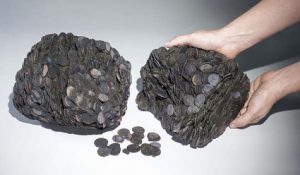Divers discovered in the port of ancient Caesarea (modern Israel) a cargo of a merchant ship that sank there during the Late Roman period, about 1,600 years ago. Archaeologists from the Israel Antiquities Authority conducted research at the site and found numerous objects such as iron anchors, remains of wooden anchors and items that were used in the construction and running of the sailing vessel.

Many of the artefacts are made of bronze, such as a lamp depicting the image of the sun-god Sol, a figurine of the moon goddess Luna, a lamp in the image of the head of an African slave, fragments of three life-size bronze-cast statues, objects fashioned in the shape of animals: a whale, and a bronze facet in the shape of a wild boar with a swan on its head. Fragments of large jars were found that were used for carrying drinking water for the crew on the ship. One of the biggest surprises was the discovery of two metallic lumps composed of thousands of coins weighing about 20,5 kg.

A preliminary study of the iron anchors suggests there was an attempt to stop the drifting vessel before it reached shore by casting anchors into the sea; however, these broke – evidence of the power of the waves and the wind which the ship was caught up in.

The coins that were discovered bear the image of the emperor Constantine who ruled the Western Roman Empire (312–324 CE) and was later known as Constantine the Great, ruler of the Roman Empire (324–337 CE); and of Licinius, an emperor who ruled the eastern part of the Roman Empire and was a rival of Constantine, until his downfall in the 324 CE Battle of Adrianople that was waged between the two rulers. Following the battle at Adrianople, Constantine moved to besiege Byzantium.

(after The Jewish Press)